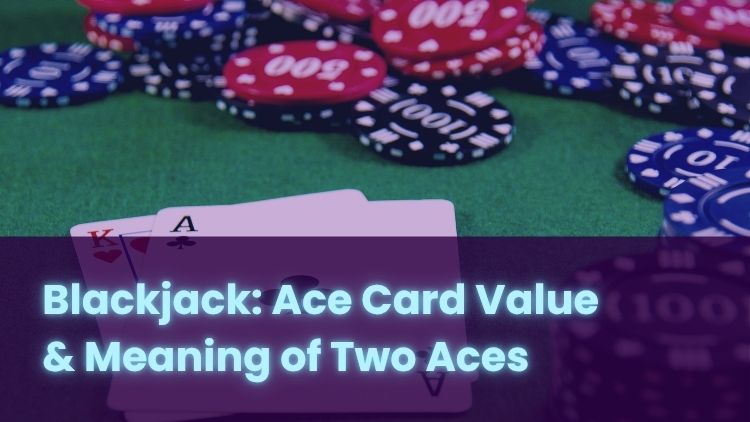
In UK blackjack, the ace is the most flexible card in the deck. It can change the value of your hand, offering opportunities that other cards cannot. Knowing how the ace works — and what can happen if you’re dealt two — helps you understand why this single card can make such a difference.
This guide explains how aces are valued, how they behave under UK rules, and why splitting them is often treated differently. While blackjack includes an element of chance, understanding the ace can help give you a clearer picture of how each hand may unfold.
What Is the Value of an Ace in Blackjack?
In UK blackjack, based on European rules, the ace counts as 1 or 11, whichever keeps your total at 21 or below. For example, an ace and a 7 can total 8 or 18. If an extra card would push your total over 21, the ace automatically becomes 1.
A hand with an ace that can still count as 11 is known as a soft hand — for instance, ace and 6 is a soft 17. Once the ace must count as 1 to stay under 21, it becomes a hard hand, such as 10 and 7 (hard 17).
Numbered cards are worth their face value, while picture cards (Jack, Queen, King) each count as 10. Most UK casinos use four to eight decks, each containing four aces.
Why Are Two Aces Considered a Strong Starting Hand?
Two aces equal a total of 12 when one counts as 11 and the other as 1. That may not sound strong, but the flexibility it offers makes it valuable.
Most UK blackjack tables allow you to split aces into two separate hands by placing an extra bet equal to your original stake. Each new hand starts with one ace, and if the next card is worth 10, that hand reaches 21.
However, under UK and European rules:
- Each split ace hand usually receives only one additional card.
- Re-splitting aces is often not allowed.
- An ace and a 10-value card after a split count as 21, not a natural blackjack. This usually pays 1:1 instead of 3:2.
These rules help balance the potential advantage of starting with aces, making them strong, but not certain winners.
How Should You Play a Pair of Aces?
Statistical analysis known as basic strategy suggests that splitting aces generally offers better potential than keeping them together. Two separate hands starting with aces give you more ways to reach a high total than a single 12.
If you don’t split, your total of 12 leaves little room to improve — a 9 gives you 21, but any 10-value card causes a bust. Splitting gives you a chance to build two competitive hands instead of one weaker one.
Before deciding, check the game rules. UK casinos and online platforms should clearly list whether re-splitting is allowed, if doubling after a split is permitted, and what possible payouts apply. Knowing this can help you make informed decisions if aces appear.
Does the Value of Aces Change During the Game?
Yes. The ace can switch between 1 and 11 as cards are drawn. For example, an ace and 6 form a soft 17. If you then draw a 9, the ace becomes 1, creating a total of 16 instead of 26, which would exceed 21.
This ability to shift keeps you in the game longer than fixed-value cards, but it doesn’t ensure success. Blackjack outcomes depend on both your hand and the dealer’s, and chance plays a key part.
What Does Splitting Aces Mean in Blackjack?
Splitting aces means separating a starting pair into two hands by matching your original bet. The dealer then adds one card to each hand.
Under UK rules:
- You typically receive only one card per split hand.
- Further splits are rarely allowed.
- The game usually follows the no hole card rule, meaning the dealer doesn’t check for blackjack until after you act.
Because of these limits, the results of split aces can vary. It can be useful to check the game’s paytable or help section before playing to better understand how the house manages any splits and payouts.
Common Misunderstandings About Aces in Blackjack
- Aces can change value. They shift from 11 to 1 if that keeps the total at 21 or below.
- Two aces don’t total 22. Only one ace can count as 11 at a time, so the starting value is 12.
- An ace doesn’t guarantee a winning hand. Even a strong start can lose depending on which cards follow.
Splitting aces doesn’t guarantee success. Restrictions on drawing cards mean the outcome can be unpredictable, and in some games, splitting may not be allowed at all. Certain casinos or online platforms use specific blackjack variations that limit when or how a pair of aces can be split. Checking the table or paytable rules before playing can help you understand what’s permitted.
Understanding these points can help you read the game more clearly and respond to each hand with awareness, rather than assumption.
Blackjack is a game of chance. Results can’t be predicted or influenced. If you decide to play, it’s sensible to set personal limits on how much time and money you want to spend before you begin. Once those limits are reached, stop playing. The aim is to keep it enjoyable and responsible.
*All values (Bet Levels, Maximum Wins etc.) mentioned in relation to these games are subject to change at any time. Game features mentioned may not be available in some jurisdictions.
**The information provided in this blog is intended for educational purposes and should not be construed as betting advice or a guarantee of success. Always gamble responsibly.
